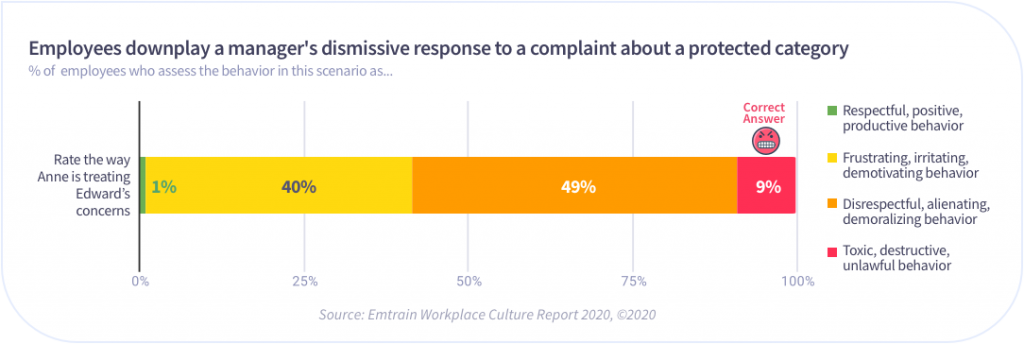What if your managers aren’t taking employee complaints as seriously as they should?
Note: This issue feels even more urgent now that employees are experiencing the stress from the coronavirus pandemic, trying to manage new safety precautions in the workplace or transitioning to work from home all while protecting themselves and their loved ones. While we focused on formal complaints and incidents in the research shared below, the lessons for managers apply similarly to day to day interactions with their subordinates.
Are your managers taking employee complaints seriously? Apparently not—according to our Workplace Culture Report 2020, “one in ten employees said that they would not trust their management to take them seriously if they made a complaint.”

For context, our data set is derived from polling in online training for managing unconscious bias and preventing workplace harassment. When we’re talking about complaints, we’re most often talking about serious issues that should be raised to management and promptly investigated.
Why aren’t managers taking complaints seriously?
Our data set covers 40,000 employees at 125+ diverse companies across a range of industries and geographies, so it’s safe to say it’s not just a bunch of brand new managers at tech companies who don’t know better. (That said, some of our clients are high-growth tech companies who have done rapid promotion of early employees to managers–we’re helping with new manager training.)
We found that an array of factors, including in-group/out-group dynamics, power dynamics, unconscious bias, and low social intelligence, may influence a manager’s opinion and handling of an issue. On the flip side, these factors can also impact whether an employee feels safe enough to raise a complaint. We dig into the details below.
A manager may dismiss or discount a complaint if they’re part of an in-group
In-group/out-group dynamics involve the human tendency to categorize people as “us” or “them.” This dynamic exists in all organizations: in-groups and out-groups may exist around gender, race, age or other personal interests, political beliefs, and more. When a certain in-group is more dominant and favored within the workplace, it shapes the experience of the out-group.
We consider two such scenarios in video scenes in our courses:
One scenario shows an older employee telling his younger boss about an issue he’s having with a Millennial colleague: the colleague is making snarky comments about his age, and calling him Grandpa in group meetings. The manager hides a smile and at first tries to dismiss his concern, then defers it, promising to focus on it later. Watch the scene here.
We ask learners to assess the severity of the incident, and only 9% correctly identify it as harassment.

In a second scenario, an employee repeatedly refuses to call a transgender colleague by her chosen name. Watch the scene below.
When asked if it is reasonable for the colleague to feel excluded by this behavior, almost 1 in 10 people say it was not. 83% of employees rate this scenario as less severe on the Workplace Color Spectrum® than it actually is.

Because our workplaces are becoming increasingly diverse, managers need to be hyper-aware of any bias in how they treat “others,” particularly those who are in the minority in their workplace and are likely part of the out-group. Our research indicates that managers may be missing key signals when considering complaints.
An out-group employee is in a complicated position if they have a complaint to raise
In-group/out-group dynamics don’t just have implications for how managers handle complaints. The actions of the employee are also affected. When look at the group of learners who indicate that they “have had to minimize part of their heritage or personal identity to fit into a job” (a good proxy for an out-group), we find that they are 18% less likely to feel comfortable speaking up and 23% less likely to think their management will take the complaint seriously if they do complain.

Managers dismissing or mishandling complaints due to a variety of social dynamics may create a perpetual cycle that challenges the trust between management and colleagues.
Employees don’t see much empathy from their managers
Only 31% of employees say that managers in their organizations show empathy and curiosity toward their direct reports. Managers who don’t demonstrate empathy are less likely to be perceived as understanding employee concerns and more likely to be perceived as having selfish motives for their actions. We shared more on this concept in our recent blog, Why Empathy in the Workplace is Crucial for All. When you combine a lack of empathy with power dynamics, situations can escalate.
In a video scene on retaliation, we learn that an employee has raised a complaint specific to her manager. The manager then assigns that employee to another team member for an upcoming client project. Though the manager explicitly states that her motivation for the reassignment was to reduce friction in the project, her

actions are interpreted very differently by the employee who sees it as retaliation and is additionally frustrated that she is now reporting to a peer. Watch the scene here.
Our learners were evenly split when asked what they thought the real motivation for the reassignment might be, with a full 41% of people believing the manager used her power to intentionally get back at the employee.
People with less power are reluctant to speak up, in part because they fear a lack of support or retaliation. As a result, managers with good intentions (but low social awareness), as well as the few managers who engage in frequent inappropriate behavior, are not getting feedback that might help them rethink their actions.
We also found a strong correlation between two of the factors we researched:
- How frequently people in authority get away with disrespectful behaviors and,
- Whether employees believe their complaints will be taken seriously if they do speak up

It makes perfect sense that in an organization where bad behavior is ignored or even permitted for certain leaders in authority, employees wouldn’t expect their complaint to be taken seriously. To extrapolate further, it’s perfectly logical that people would feel less comfortable reporting a situation they experienced or observed, thus not even sun-shining the bad behavior, leaving the perception that things are just fine when in fact, they are quite toxic. This unhealthy workplace culture then becomes a negative norm.
For the employee who does raise a complaint despite significant headwinds, it magnifies the seriousness of the complaint and their bravery to raise it. Managers should have that in mind too.
Positive organizational norms also impact how managers perceive complaints
Despite the written mission, values and code of conduct, organizations have norms around how people interact: some workplaces are highly respectful, others less so. Strong positive norms corral bad behavior, help give employees the confidence that their complaints will be taken seriously, and help guide managers to ensure they don’t make inappropriate requests, because “that’s the way things work around here.”

Whether you’re a manager yourself, or an HR leader looking to help others with fair but firm leadership, being aware of these issues can help you identify when things might be out of balance. Instead of being annoyed when someone raises an issue, managers should take a moment to appreciate it when someone trusts them and the system enough to bring forward a complaint. Pause before making assumptions, consider the circumstances of the employee, and your own bias and privilege as someone with authority before you dismiss or defer the issue. As we teach in our courses, many situations that may seem minor actually have protections under the law–and the way you handle your own behavior and respond to that of others sets an organizational norm that has influence long beyond the situation at hand.
Note: The data provided in this blogpost is from Emtrain’s Workplace Culture Report 2020. Data was derived from over 40,000 employees at 125+ companies who completed mandatory Preventing Workplace Harassment training and voluntary Managing Unconscious Bias training in 3Q and 4Q 2019.
For more workplace culture statistics, download our Workplace Culture Report 2020.
For a Workbook to help you think through your workplace culture factors, see our Toxic Culture Symptoms Checklist.
To see how we use these videos within our online Preventing Workplace Harassment training program, and the culture analytics we derive from them, request a demo here.










